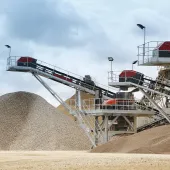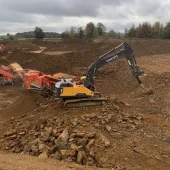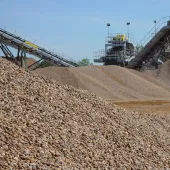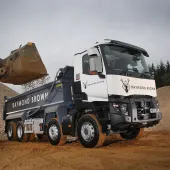Aggregate Supply Challenges Re-Emerge

Nigel Jackson, chief executive of the Mineral Products Association, discusses the current constraints on aggregate supply and outlines some of the steps necessary to ensure demand can be met in the long term
Previously, I have likened aggregate supply to plumbing. The tank is a proxy for permitted land-won reserves, with pipes/pipelines being a proxy for ‘capacity to supply’ for all sources of supply – the six main aggregate ‘sources of supply’ being:
- Recycled
- Secondaries
- Land-won rock
- Land-won sand and gravel
- Marine
- Imports
In 1973 the national ‘tank’ for England and Wales held around 7 billion tonnes of permitted reserves and the ‘pipes’ were supplying up to 270 million tonnes per annum of primary aggregates. Today the ‘tank’ is estimated to hold less than 4 billion tonnes but is only having to supply around 150–200 million tonnes per annum, with recycled and secondaries contributing around a further 60 million tonnes per annum.
This is quite a change. In 40 years we have consumed more than 40% of our permitted reserves at the same time as reducing our call on them by using alternatives and being more resource efficient and less intense in our use.
Some say, ‘4 billion tonnes at a drawdown rate of 200 million tonnes per annum still gives us 20 years’ supply, what’s the problem?’. Compared with the parlous state of our energy supplies, this looks eternal. However, as we all know, this is not the case at all as it takes no account of location, logistics, control or ‘pipeline management’, let alone devolution and planning constraints. The first impression of aggregate supply flatters to deceive.
Fortunately, the Managed Aggregate Supply System (MASS) in England, which has evolved since the ‘Verney Report’ in 1975, has served us tolerably well in spite of the diminishing stock of permitted reserves. We can only speculate as to where we would have been without it – almost certainly in a much worse place. We should not forget that over the years there have been dramatic changes, all of which have contributed to making it harder for the MASS to deliver ‘adequate and steady supply’ for the long term.
Among the influences are radical restructuring of the industry creating the challenge for major companies of having to compete for long-term capital investment from overseas owners, coupled with more localized access to capital issues for SMEs.
This has not been helped by a weakening and, arguably, shrivelling of both mineral planning and mineral surveying as career choices, the loss of too many skilled local authority mineral planners and, to some extent, the loss of similar skills within operating companies. Where once some companies had their own exploration teams and drillers this is now normally outsourced as a variable cost, and with it the passion for exploration is dulled.
Recessions have not helped. Lower demand means less cash to play the long-term game and to speculate with land and the planning system. A more risk-averse operating environment naturally inhibits the desire to take bold and strategic action for the longer term.
Overall momentum on reserve replenishment has slowed and whilst it is easy to slow things down when demand drops, when it picks up again supplies get stretched as any inertia that may have set in makes it harder to ‘gear back up’.
Acquiring land is never quick nor easy and downturns do disrupt the steady flow of sites into the ‘pipeline’.
So, we know we have less stock and as the economy grows the false protection that five years of recession gave to our permitted reserves has gone and we must return to the pre-recession challenge of addressing how long-term demand will be met. In some areas and for some sources of supply we are even having to consider how short- and medium-term demand will be satisfied.
What else do we know? The MPA’s Annual Mineral Planning Survey (AMPS) reports help inform us about some of the key realities of the MASS today:
- Applications for new reserves have been low and inconsistent for some years
- Applications for extensions have been comparatively stable and preferred as the means to ‘stay in business’, being less risky and capital intensive
- Crushed rock permitted reserves have been replenished at or close to parity (ie 100%), although this is largely arithmetical as a few big permissions tend to spike and distort the bigger picture
- Sand and gravel continues to be significantly and cumulatively under-replenished at around 50%
- Applications typically take two to four years to secure, although success rates are still around 85%
- Application costs are typically £100,000 to £850,000
- Plan coverage remains parlous some seven years after full coverage was intended with only around 50% of core strategies in place, but more significantly only around 25% of site allocations in plans in place
- More than 50% of permissions are granted outside of plan allocations.
These are just some of the salient factors with regards to land-won aggregates, just one of the six sources of supply. All of the others have differing constraints to varying degrees.
Recycled is now an embedded part of the supply chain but has limited scope to grow and is linked mainly to growth or decline in construction output. No matter how many times we talk about the ‘circular economy’, we cannot recycle away the need for the majority of future supply to be met from primary sources.
Secondaries still have scope to grow but they continue to make only a comparatively small contribution to supply.
Crushed rock is performing a wider and deeper role than 25 years ago as it substitutes increasingly for sand and gravel, but its reach is neither universal nor even. It is a generation since a new, large, rail-linked rock quarry was permitted, and whilst a number of the nationally significant ‘big bangers’ have successfully secured extensions, big reserves do not necessarily equate to additional ‘capacity to supply’. ‘Tanks’ can be refilled but the ‘pipes’ are sometimes difficult to widen.
Marine aggregates remain a vital source of supply, particularly for London and the South East. Vast new resources and reserves are now available in the eastern English Channel coupled with the re-licensing of historic licences. However, the constraints on this sector are an ageing dredging fleet – on average around 21 years old – and encroachment by residential developments on poorly safeguarded wharves. Where will new dredging capacity come from and how many wharves will still be active in 10 years or be able to cope with larger ships?
Imports continue to play their part but as yet not so significantly as to make a meaningful difference to the supply mix.
Most of these very simplistic observations have underlying complexities and are, indeed, open to alternative points of view. This is not a definitive narrative. What is undeniable, however, is that the diminishing size of the overall national landbank of permitted aggregate reserves and constraints on supply mean that there is no cause for complacency for any of the key actors, whether they be the DCLG, mineral planning authorities or the industry.
Critical to all this is:
- Determining a reasonable envelope of likely future demand
- Securing accurate data and evidence of current supply dynamics
- Developing reasonable ideas of how the supply mix could vary and identifying the infrastructure required to enable it
- Developing a series of scenarios which combines all the key variables
- Intensifying the dialogue between the industry, planners and government.
In short, a healthy, well-resourced and engaged MASS.
The MPA will continue to lead on these issues for industry and present more hard evidence to inform the debate for the sector for the benefit of companies, whether large, medium or small. In 2016 we intend to go further. We are developing a number of scenarios of potential supply mix on similar lines to those which typify the energy sector. Why? To ensure that government is aware of what needs to happen to ensure that the decline in reserves and the ‘capacity to supply’ constraints are recognized, and that action is taken to ensure that the national ‘tank’ is full enough and the ‘pipelines’ can deliver an adequate and steady supply.
With cutbacks in government biting ever deeper and with a broad shift of emphasis to industry ‘having to do more and more of what used to be done by government’, we have to continue to develop the skills and build the resources to make sure we can articulate a vision of how demand will be met in the long term. We will rise to that challenge.








